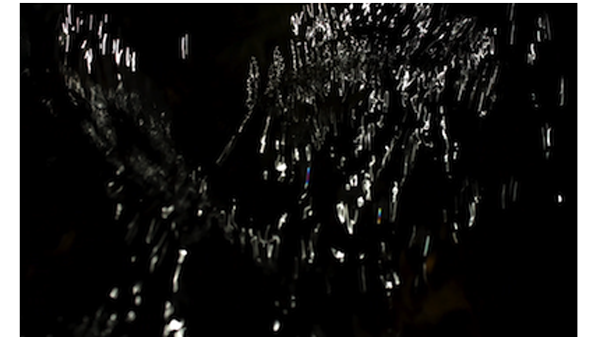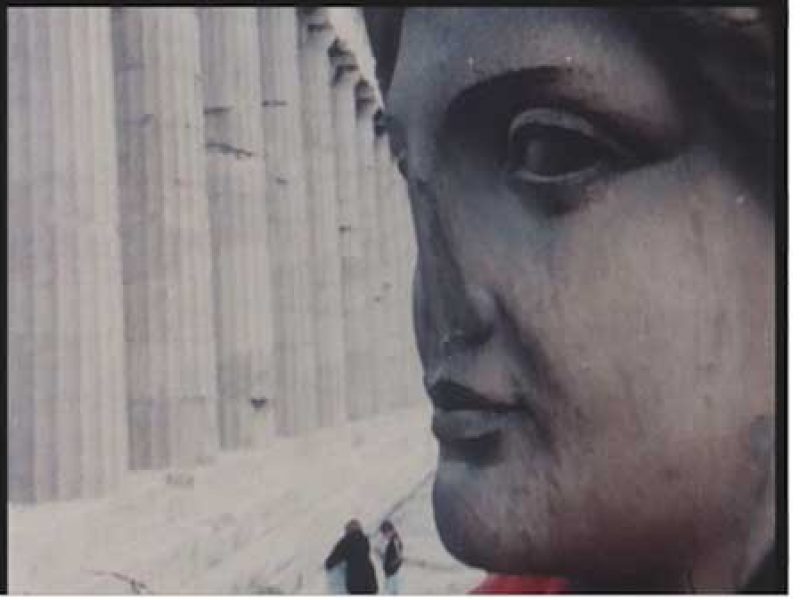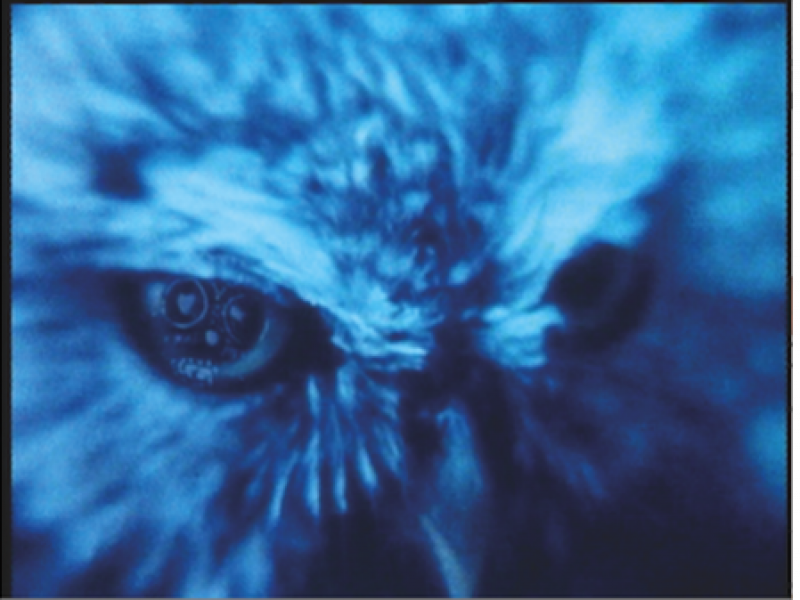In this interview LUX artists The Otolith Group discuss their Turner Prize exhibition, currently on at Tate Britain, and their new work Hydra Decapita (2010), currently at Manifesta 8, in relation to a diverse research practice combining essayistic montage, discursive space and didactic methodology.
Interview continued from PART 1…
GL: So, to link back to the initial points; collaboration as potential controversy, the self-learning approach of your practice, understanding the role of spectatorship and relating that to an essayistic learning with other people’s work. How do you see those elements in relation to the work you are currently producing?
KE: Let us say that this new cycle of work that we have embarked upon is oriented around the question of how to think through economic crisis as a question of abstraction. One way to envision the political crisis of neoliberalism that we are living through is to envision personal tragedies; the tragedy of somebody who has been laid off work or whose savings have been wiped out.
AS: What we are interested in is trying to envision systemic crisis. Critics such as Mark Fisher, Nina Power and Alberto Toscano are thinking through these questions. How do you formulate a poetics of abstraction that is as abstract as economic reality itself? An abstraction that is equivalent to the abstraction we live through every day? Do we have to use economic language to understand political crisis? What are the forms and modes that can begin to evoke real kinds of abstraction? These are the questions that we are asking ourselves.
KE: One way to think about this is in relation to a history of the present that proposes a relation between finance capital and death by relating what we know as the Atlantic slave trade of the 18th century to what we know as the financial market. What becomes thinkable if the Atlantic slave trade can be understood as the inauguration of what we understand as the finance market. Crudely summarised, this is the relation proposed by Ian Baucom in his 2005 book Specters of the Atlantic: Finance Capital, Slavery and the Philosophy of History. Baucom conducts an enquiry into the archives of the Zong slave ship that was owned by a consortium of Liverpool slave owners. On its way back from the Caribbean in September 1781, the Zong lost direction and encountered a storm. The captain, Luke Collingwood, decided to throw 133 slaves overboard over 3 days and to claim for loss of cargo which the marine insurers refuse to pay. At the trial in London in 1783, the consortium won. The insurers appealed. There was a second case. The consortium won the appeal. The same year there was an unsuccessful appeal by the abolitionist Granville Sharp to retry the case as murder.
It is a fascinating book; what Baucom argues is that the relation between finance capital, marine insurance and death emerges due to the duration of the trade between Africa, Caribbean, America and Europe Slave traders paid each other in bills of exchange, with paper bearing the promise to pay. A chain of payments therefore emerged based on selling fractions of promises to pay; this constituted a transatlantic market whose security was guaranteed by a cargo that was worth more dead than alive.
The slave trade constitutes a critical episode in what Baucom calls an ‘Atlantic cycle of capital accumulation’. It is critical to understanding the history of our present. We are not so interested in the abolitionist arguments against slavery as we are in what Eyal Sivan calls the regimes of justification that are held in common by the slave trading consortium and the marine insurers. The rationalisations articulated by both sides in that courtroom in Guildhall in 1783 share a language of economic necessity.
AS: Today, most people would state that slavery is abhorrent; simultaneously, however, they would argue for some version of economic necessity. The question of reparation is not as important to us as the regime of justification. The insurance trial of 1783 was based on the economic necessity of death.
KE: What if the regime of justification proposed in 1783 persisted into the present? That persistence allows us to propose a relation that begins to formulate a constellation of episodes. 1781 links to 1783. Cut to 1840. Turner’s painting Slavers Throwing overboard the Dead and During, (Typhoon Coming On) informed by the details of the Zong case, is exhibited at the Royal Academy. In 1845, John Ruskin anonymously publishes the first volume of Modern Painters that can be seen as an inaugural moment for art criticism in England. In Chapter 14 of Modern Painters entitled Of Water, as Painted by Turner, Ruskin defends and celebrates Slavers Throwing overboard the Dead and During, (Typhoon Coming On) through a new form of art writing.
AS: This constellation of moments has been analysed by critics such as Paul Gilroy, Edouard Glissant, Simon Schama and David Dabydeen, novelists such as Fred D’Aguiar, playwrights such as Margaret Busby and poets such as M. NourbeSe Philip and Derek Walcott. Black Audio Film Collective wrote an unrealised treatment around this moment.
KE: Our interest in this constellation has a somewhat distinct point of entry. It emerges from a longstanding preoccupation with the fabulation manufactured between 1993 and 2002 by Drexciya, the Detroit based electronic duo. In those years, the duo of James Stimson and Gerald Donald who never performed live or recorded music videos of Drexciya recorded a series of singles and four albums that evoked a fictional world called Drexciya. In this fiction, women thrown overboard during the middle passage did not die but instead gave birth to babies that learnt to breathe underwater. The descendants of those babies become a new species: Drexcyians. Drexciya’s entire project can be seen as conceptualising a series of concept albums in which political atrocity is reimagined as science fiction and subjected to a redreaming that holds an appeal for us and for artists, based in the US such as Ellen Gallagher and Edgar Arcenaux, as well as critics such as Julian Myers.
In our latest work Hydra Decapita, the regime of justification formulated by the legal counsel for the Zong in the first trial of 1783, Turner’s experiment with colour in 1840 and Drexciya’s fabulation between 1993 and 2002, provide us with a constellation through which we can begin to map an affective cartography of the real abstraction of finance capitalism.
AS: In Hydra Decapita this begins to emerge through the narration of episodes that our interviewee person who only wishes to be known as Remnant of a Hydrogen Element calls an ‘interhydratic’ cosmology.
KE: In Hydra Decapita, the role of voiceover is replaced by what we call a songover. Angelika sings two paragraphs from Chapter 14 of Modern Painters Volume I that has been set to newly composed music. What you then hear are four sections extracted from several hours of recording conducted with the figure that calls himself Remnant of a Hydrogen Element.
AS: Remnant of a Hydrogen Element has a specific cosmology. We were interested in creating a fiction that wrapped itself around that cosmology that deals with the abstraction of Drexciya that we wanted to inhabit.
Continued in Part 3 click below
The Otolith Group’s Turner Prize Exhibition is currently on at Tate Britain, London until 3 January 2011. The Otolith Group are also showing as part of the 29th São Paulo Biennial, 25 September – 12 December 2010, ‘There is Always a Cup of Sea to Sail In’, Sao Paolo, Brazil. Also Manifesta 8, Murcia, Spain until 9th January 2011 and with forthcoming Tour of Mumbai / Delhi/ Kolkatta in December and solo show at MACBA, Barcelona opening in February 2011.
Gil Leung is a writer and curator based in London. She is Distribution Manager at LUX and editor of VERSUCH journal.





